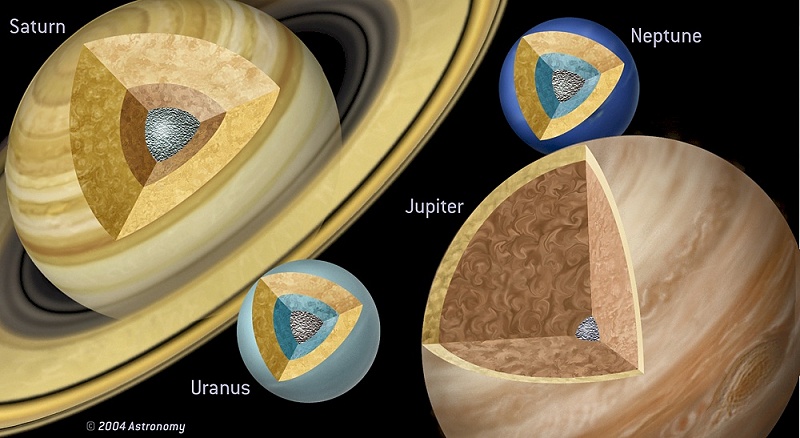
Observations of the four jovian planets, which have low average densities, show they are mainly composed of the light elements hydrogen and helium. But are they mostly gaseous, liquid, or solid?
Actually, the gaseous component forms less than the outer 10 percent of Jupiter and Saturn. These so-called gas giants are large and massive enough that in deep layers, under high pressure, the dense gas changes to liquid. The transition from gas to liquid is quite gradual. A more distinct change occurs at pressures of 1.4 million Earth atmospheres, about 4,500 miles inside Jupiter (10 percent of the radius) and 19,000 miles inside Saturn (50 percent of the radius). There, liquid molecular hydrogen transforms into a substance known as liquid metallic hydrogen, which conducts electricity. Currents in this liquid layer generate the powerful magnetic fields of Jupiter and Saturn.
In fact, it would be more precise to call the jovian planets “liquid giants.” Rotation flattens them at the poles, but the amount of flattening depends on how much solid matter exists within the planet. Jupiter’s polar diameter is about 6-percent less than its equatorial diameter, which implies that Jupiter must have a rocky core 10 times more massive than Earth (but only 3 percent of Jupiter’s mass) and about 1.5 times Earth’s diameter. Saturn, which is flattened at the poles by about 10 percent, must have a larger and less-compressed core. It’s about 2.5 times the size of Earth and contains about 15 times Earth’s mass.
These cores are solid because they are under high pressure. In Jupiter’s case, the pressure is 40 million atmospheres, and the temperature is about 23,000 kelvins (41,000° F). An ice-rich outer core surrounds its inner rock core, which contains iron and silicon. Here, ice refers to substances like water, ammonia, and methane. Despite the heat, these substances remain in a solid state because of the enormous pressure on them. Planetary scientists call this sort of ice-rock mixture a “clathrate.”
Uranus and Neptune are much less massive than Saturn, so pressures within them never reach more than 100,000 atmospheres — pressures too low for liquid molecular hydrogen to turn into metallic hydrogen and become electrically conductive. Nevertheless, both planets have strong magnetic fields. Scientists believe that these planets generate their magnetic fields in a hot, swirling mixture of water, ammonia, and methane beneath their hydrogen layers. Both Uranus and Neptune have rock-ice cores of about 1.2 Earth diameters and about 10 Earth masses. For both planets, these cores constitute a large percentage of their interiors: 60-70 percent of the mass, 30-40 percent of the radius. — RICHARD CROWE, UNIVERSITY OF HAWAII AT HILO
Do you have a question for Ask Astro? Click here to submit it.









